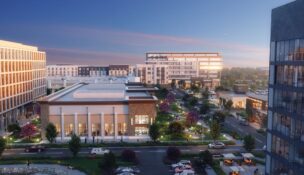Forward motion
Front Royal sees port-driven progress
Shenandoah is known for apple blossoms, but something else is popping up this spring in Front Royal: a new 340,000-square-foot warehouse logistics center.
About a half-mile from the Virginia Inland Port, the center is one of roughly a dozen projects in the region built by Equus Capital Partners Ltd., a commercial real estate agency based in the Philadelphia area.
It offers further evidence that when the Port of Virginia took a gamble and opened a rail-linked intermodal container facility in Front Royal 33 years ago, it was onto something. “We’re a huge believer in the inland port and a big fan of the region,” says Dan DiLella Jr., senior vice president at Equus.
In the years after the inland port opened, surrounding land was gobbled up for development, eventually pushing some big users of the facility — among them, Home Depot, Geodis, Rubbermaid and Mercury Paper Inc. — to Equus-built properties in the nearby Winchester area, 10 to 20 miles away, DiLella adds.
The company’s new facility, known as the Virginia Inland Port Logistics Center, sits just down the street from the port’s terminal. As of early March, at least three potential tenants were interested, DiLella notes.
The Port of Virginia earned pioneer status of sorts when it opened the Virginia Inland Port in March 1989 in Front Royal, about 70 miles west of Washington, D.C. The idea was to set up a cargo hub just a stone’s throw from Interstates 66 and 81, linked by rail to the port’s ocean terminals about 220 miles to the south.
It worked.
Virginia was able to divert cargo from Baltimore, as officials had hoped, and surpass it as a container port. In 2010, the port resorted to the same playbook when it leased the aging Port of Richmond on the west side of the James River just south of the city, next to Interstate 95.
The Virginia Port Authority eventually poured $24 million in state, federal and its own funds into what is now known as Richmond Marine Terminal, where a river barge service hauls containers to and from Hampton Roads on three round-trip sailings a week along the James.
At a time when clogged ports worldwide have generated headlines, both of Virginia’s inland-port facilities have served as safety nets for the port’s big container facilities in Portsmouth and Norfolk, helping to maintain fluidity as cargo volume grows.
Improvements in Richmond, such as an expanded, modernized gate complex, are nearly complete, while $26 million in upgrades planned since 2018 in Front Royal are still in the pipeline.
The two inland ports’ container volumes last year — 31,282 in Front Royal and 40,058 in Richmond — amounted to just a small fraction of the port’s overall volume of nearly 2 million containers, though Port spokesman Joe Harris says it’s a critical fraction because of the role the ports play in keeping container volume in Hampton Roads moving.
In January 2022, a study of the port’s fiscal year 2021 economic impact by William & Mary’s Raymond A. Mason School of Business found that the contributions from Front Royal and Richmond dipped slightly from those reported in a fiscal year 2018 study.
“The big story here is supply chain crisis,” says W&M international business and marketing professor K. Scott Swan, who conducted the study, adding that a shortage of containers created because of scores of marooned ships, especially off the West Coast, created a frenzy to get freshly emptied boxes on their way back to ships without delay.
The inland ports’ economic value “goes far beyond just moving containers,” Swan’s study notes, highlighting value-added purchases, labor income and employment among their contributions.
Late last year, the state announced that Montreal-based Nature’s Touch Frozen Foods LLC, a global supplier of frozen fruit, was expanding in Front Royal, building a 126,000-square-foot facility across the street from its current smaller location. It’s expected to open in early 2023.
Though its existing operation sits virtually next door to the inland port, Nature’s Touch has not been a customer because of special refrigeration needs unavailable there.
“We’ve had limited success using the inland port today,” says John Tentomas, president and owner of Nature’s Touch. His company’s decision to expand there, however, was made with the understanding that the situation will change soon. “We expect to be using it,” Tentomas adds.
Nature’s Touch’s new complex is being built by Harrisonburg-based InterChange Group Inc., a third-party logistics provider with extensive warehouse operations in Virginia.
“Larger companies are using the inland port,” says InterChange President Devon Anders, citing a difference between companies moving five containers a month and those moving 100.
At Front Royal, companies experience something unusual, he adds: “Getting in and out of the inland port is absolutely wonderful. … Their turn times are so quick,” Anders says, referring to the total time it takes trucks to load and unload at the terminal.
The soon-to-open Equus facility will be in the same neighborhood as Nature’s Touch, Anders notes. “They wouldn’t be doing that if they didn’t think there was a market there.”
F















